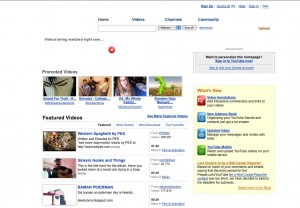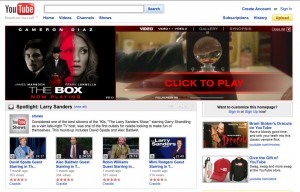I’ve often said that you need to logout of your account to see what YouTube really looks like, since that’s what the majority of viewers are seeing. Let’s look at one of last year’s last Archive.org homepage screen shots of YouTube, and compare it to today’s.
Some differences:
- 2008 has lots of white space and simplicity like Google. Today’s homepage features a film ad that dominates almost the entire “above the fold” region.
- The content featured on 2008’s page is mostly consumer-generated or amateur. Today it’s Crackle content and yesterday was FunnyorDie.
- Last year’s page featured new functionality. Today’s features a “house-ad” for YouTube/Google’s store (watch out for those Lava lamps… they sometimes forget the logo).
- The featured videos, like on Break.com, were new each day and remained constant. Today we see a variety of videos rotating, and many are popular amateur videos (mixed with some advertised content). We’ve shifted from homepage featuring to “mini-featuring” via “spotlight tagging.”
- The biggest change is not evident on the homepage. Now the power-engine behind YouTube views is “related videos,” which can account for a significant portion of views.
Again, YouTube is behaving less like parent Google and more like Yahoo.com or a media company. Perhaps the price it can fetch for a homepage takeover is too tempting to resist. It’s a great way to get a film “top of mind” awareness to jump-start a weekend box offices, or a television debut (and I was especially impressed with V’s custom YouTube ad unit). And who can fault YouTube, which bears the bandwidth cost of so much unprofitable consumer-generated content to lure mainstream users with semi or pro content that can be better monetized?
Still, it’s remarkable what a difference a year can make. From where I sit, the biggest flaw in the user-interface is that it’s not entire inviting to visit the most-popular or genre-specific videos. One tends to use the homepage as a search engine, or be drawn to whatever thumbnail or title that happens to appear below the ad-du-jour.
I’ve suggested before that the day of the YouTube editor is behind us, because the sub-page featured videos don’t seem to garner significant views. However I’d suspect “spotlight” videos are driven not just by algorithms (most-viewed, longest average viewer duration, highest rated, related) but by editor preferences. If I’m right, the editors still have an active hand in deciding what YouTube amateurs find audiences. Interestingly we tend to see a few dozen of the same Partners with the most active rotation, which suggests editorial favor-ability or content favored by “crowdsourcing” as defined by the engineers.



